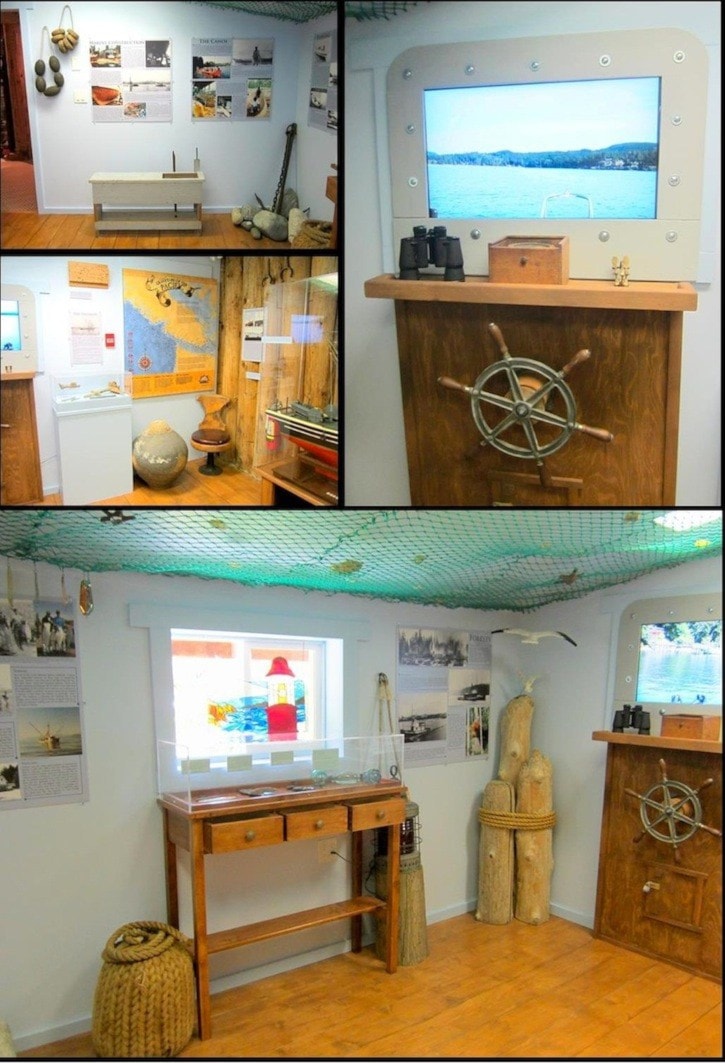This month we’re taking you way back to year 2012 when the Sooke Region Museum opened its new permanent maritime history exhibit. The exhibit was a major project for the museum during a time of great change as new director, Lee Boyko, was taking lead. Starting in November 2011, curating the exhibit took eight months. The exhibit covers topics such as ship and canoe building, fishing types, equipment, shipwrecks and salvaging. Interviews took place over the eight months with Elida Peers, Maywell Wickheim, Ray Vowles, Doug MacFarlane, Andrew Barry, and from T’Sou-ke Nation Jack Planes, Michelle Thut and Jonathon Ryce. Other contributors helped bring the research full circle.
The old Chamber of Commerce office inside the museum was transformed to look like the inside of a ship. This was a huge undertaking that was made possible by many staff and board members and volunteers. The carpet was removed and wood was laid to look like real planks in a ship. The entire ceiling is draped in a green fishing net with various shells and fishing lures attached. We designed a portal window to frame a video that plays of a ship sailing into the Sooke Harbour. Below the video is a captain’s wheel and gears. It’s a great station for kids to steer the wheel and pretend they are the captain of the sailing ship. A fish net station is a hands-on feature in the exhibit and has multiple kinds of netting needles to handle. A cabinet was built specifically for the exhibit by volunteer Jim Eaton and a plexi-glass cover was made for it to house artifacts. A large model ship named Skye-G, carved by Harvey George, is also on display.
One of the highlights of the exhibit is a light up map of the Graveyard of the Pacific. It was custom-built by Vancouver shipwreck specialist Phil Hood. He had designed a version of the map previous to the exhibit but we worked collaboratively to add information pertaining to the Sooke region and surrounding areas. Shipwrecks mentioned in the exhibit are highlighted on the map.
A particularly interesting artifact on display is a chair believed to be from the steam ship the SS Valencia. The Valencia was wrecked near Pachena Point, along the West Coast Trail, on January 22, 1906 as it was making its way from San Francisco to ports in Victoria and Seattle. The ship crashed into rocks due to a number of bad choices on the captain’s part. As it was sinking there was poor communication about the life boats and a lack of help from people on shore resulting in 136 men, women and children dying. The tragic event is recognized as “the most shameful incident in Canadian maritime history.” This chair was salvaged near Clo-oose. Other shipwreck artifacts on display include bolts, nails, and Douglas-fir fragments from the sunken schooner the Favorite.
A high point of the curating process involved working with members of the T’Sou-ke First Nations. Interviews focused a lot on the renewed interest in building traditional canoes. Starting in 1991, eight new ceremonial, warrior, and racing canoes were carved with the help of local youth. One of the vessels was carved from a single red cedar log and is Canada’s largest warrior canoe called Kwa-Quy-Aq. While researching for the exhibit, carver Jonathon Ryce showed me where the canoe was being housed at the band hall and also some of the tools that were used to create it such as a draw knife. The canoe is approximately 52’6” long.
The exhibit opened along with that summer’s temporary exhibit (Sooke: Connections to Royalty) on Sunday June 24, 2012 at our annual salmon barbeque and open house. It continues to be one of our most popular exhibits for families due to the hands-on elements.
Brianna Shambrook
Collections and Exhibits
Manager
Sooke Region Museum
